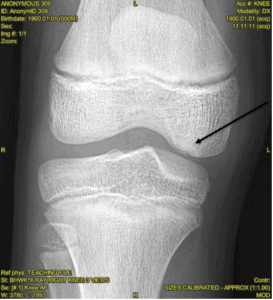Published on
Differential Diagnosis
- Achondroplasia
- Aseptic necrosis
- Meniscus tear
- Osteochondritis dissecans of the medial femoral condyle
- Punctate epiphyseal dysplasia

Figure 2.
Diagnosis
The image shows osteochondritis dissecans of the medial femoral condyle, which occurs most typically in patients between 9 and 18 years of age.
Learnings
- Osteochondritis dissecans (OCD) of the medial femoral condyle is often the result of repetitive injury or growth disturbances
- The knee, talar domes, and elbows are common locations, though it can occur in other locations
- Typical OCD lesions appear as a semilunar bone fragment along the articular surface separated from the parent bone by a lucent zone
- The OCD lesion is caused by loss of blood supply to the subarticular bone leading to a focal bone necrosis. Absorption of the necrotic bone deprives the support to over lying articular cartilage, which becomes prone to trauma, tears and fissures
- Symptoms include pain, limited mobility of the joint and locking
Pearls for Urgent Care Management and Consideration for Transfer
- Treatment and prognosis vary according to the age of the patient
- In children with nondisplaced fractures, initial treatment includes limitation of activity with the use of crutches and restricted range of motion
- Nonopioid pain medication and nonsteroidal anti-inflammatory drugs may control discomfort and swelling
- Normal activity may be resumed upon healing of the OCD lesion, and when quadriceps strength has returned to within normal limits
- If symptoms do not resolve in 6–12 months, surgical treatment may be required
Acknowledgment: Images courtesy of Teleradiology Specialists.
A 17-Year-Old Male with Knee Pain After a Fall
1 2
